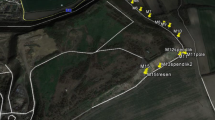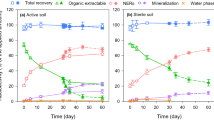Abstract
Water extracts of soil samples of the former ammunition plant “Tanne” near Clausthal-Zellerfeld, Lower Saxony, Germany, were investigated for highly polar oxidized 2,4,6-trinitrotoluene (TNT) metabolites. 0.4 to 9.0 mg/kg dry soil 2,4,6-trinitrobenzoic acid (TNBA) and 5.8 to 544 mg/kg dry soil 2-amino-4,6-dinitrobenzoic acid (2-ADNBA) were found. In addition to the oxidized metabolites, TNT, 4- and 2-aminodinitrotoluene (4- and 2-ADNT), and 2,4-dinitrotoluene (2,4-DNT) were extractable with water. Most interestingly, in one sample, 2-ADNBA represented the main contaminant.
The origin of the oxidized nitroaromatics is unknown at this time. They might be generated chemically or photochemically. Furthermore, a biological synthesis seems possible.
Similar content being viewed by others
References
Dilley, J.V.;Tyson, C.A.;Spanggord, R.J.;Sasmore, D.P.;Newell, G.W.;Dacre, J.C. (1982): Short-term oral toxicity of 2,4,6-trinitrotoluene in mice, rats and dogs. J. Toxicol. Environ. Health9, 565–586
Drzyzga, O.;Gorontzy, T.;Schmidt, A.;Blotevogel, K.-H. (1995): Toxicity of explosives and related compounds to the luminescent bacteriumVibrio fischeri NRRL-B-11177. Environ. Contam. Toxicol.28, 229–235
Smock, L.A.;Stoneburner, D.L.;Clark, J.R. (1976): The toxic effects of trinitrotoluene (TNT) and its primary degradation products on two species of algae and the fathead minnow. Water Res.10, 537–543
Tan, E.L.;Ho, C.H.;Griest, W.H.;Tyndall, R.L. (1992): Mutagenicity of trinitrotoluene and its metabolites formed during composting. J. Toxicol. Environ. Health36, 165–175
H.-G. Neumann (1996): Toxic equivalence factors, problems and limitations. Food and Chemical Toxicology34, 1045–1051
Ro, K.S.;Venugopal, A.;Adrian, D. D.;Constant, D.;Qaisi, K.;Valsaraj, K. T.;Thibodeaux, L. J.;Roy, D. (1996): Solubility of 2,4,6-trinitrotoluene (TNT) in water. J. Chem. Eng. Data41, 758–761
Gorontzy, T.;Drzyzga, O.;Kahl, M.W.;Bruns-Nagel, D.;Breitung, J.;v. Low, E.;Blotevogel, K.-H. (1994): Microbial degradation of explosives and related compounds. Crit. Rev. Microbiol.20, 265–284
Vanderberg, L.A.;Perry, J.J.;Unkefer, P.J. (1995):Catabolism of 2,4,6-trinitrotoluene byMycobacterium vaccae. Appl. Microbiol. Biotechnol.43, 937–945
Schmidt, T.C.;Steinbach, K.;v. Low, E.;Stork, G. (1998): Highly polar metabolites of nitroaromatic compounds in ammunition waste-water. Chemosphere, 37, 1079–1091
Bruns-Nagel, D.;Breitung, J.;v. Low, E.;Steinbach, K.;Gorontzy, T.;Kahl, M.;Blotevogel, K.-H.;Gemsa, D. (1996): Microbial transformation of 2,4,6-trinitrotoluene in aerobic soil columns. Appl. Environ. Microbiol.62, 2651–2656
Brooks, L.R.;Jacobson, R.W.;Warren, S.H.;Kohan, M.J.;Donelly, K.C.;George, S.E. (1997): Mutagenicity of HPLC-fractionated urinary metabolites from 2,4,6-trinitrotoluene-treated fischer 344 rats. Environmental and Molecular Mutagenesis30, 298–302
Steinbach, K. (1998): unpublished data
Fiorella, P.D.;Spain, J.C. (1997): Transformation of 2,4,6-trinitrotoluene byPseudomonas pseudoalcaligenes J. Appl. Environ. Microbiol.63, 2007–2015
Rieger, P.-G.;Knackmuss, H.-J. (1995): Basic knowledge and perspectives on biodegradation of 2,4,6-trinitrotoluene and related nitroaromatic compounds in contaminated soil. In: Biodegradation of Nitroaromatic Compounds,Spain, J.C. (Ed.).; Plenum Publishing Co., New York, 1–18
Gilcrease, P.C.;Murphy, V.G. (1995): Bioconversion of 2,4-diamino-6-nitrotoluene to a novel metabolite under anoxic and aerobic conditions. Appl. Environ. Microbiol.61, 4209–4214
Bruns-Nagel, D.;Drzyzga, O.;Steinbach, K.;Schmidt, T.C.;v. Löw, E.;Gorontzy, T.;Blotevogel, K.-H.;Gemsa, D. (1998): Anaerobic/aerobic composting of 2,4,6-trinitrotoluene-contaminated soil in a reactor system. Environ. Sci. & Technol.32, 1676–1679
Neumeier, W.;Haas, R.;v. Löw, E. (1989): Mikrobieller Abbau von Nitroaromaten aus einer ehemaligen Sprengstoff-produktion, Teil 1:. Abbau von 2,4,6-Trinitrotoluol (TNT). Forum Städte Hygiene40, 32–37
v. Löw, E.;Kaminski, L.;Neumeier, W.;Haas, R.;Steinbach, K. (1989): Mikrobieller Abbau von Nitroaromaten aus einer Sprengstoffproduktion, Teil 2: Migration und Metabolisierung von 2,4,6-Trinitrotoluol (TNT) im Grundwasser. Forum Städte Hygiene40, 347–349
Breitung, J.;Bruns-Nagel, D.;Steinbach, K.;Blotevogel, K.- H.;Gorontzy, T.;Dillert, R.;Winterberg, R.;Stoffers, H.;Haas, R.;Müller, M.;Asbach, P.;Kaminski, L.;v. Löw, E.;Gemsa, D. (1996): TNT in Komposten und Flüssigkultur: Bildung von polaren aromatischen Aminen. UWSF — Z. Umweltchem. Ökotox.8, 249–254
Fründt, J. (1998): Aerobe mikrobiologische Abbauversuche von 2,4,6-Trinitrobenzoesäure; diploma thesis, Fachhochschule Gießen-Friedberg, Germany/Inst. f. Umwelthygiene, Universität Marburg
Author information
Authors and Affiliations
Corresponding author
Rights and permissions
About this article
Cite this article
Bruns-Nagel, D., Schmidt, T.C., Drzyzga, O. et al. Identification of oxidized TNT metabolites in soil samples of a former ammunition plant. Environ. Sci. & Pollut. Res 6, 7–10 (1999). https://doi.org/10.1007/BF02987113
Received:
Accepted:
Issue Date:
DOI: https://doi.org/10.1007/BF02987113




